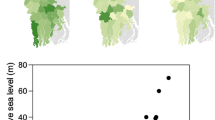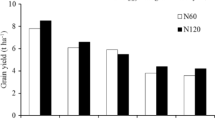Abstract
The effect of varying the sulfur (S) and nitrogen (N) supply on theyield and composition of brown rice (Oryza sativa L.)grainwas studied to determine whether grain analysis could be used for the diagnosisof S deficiency in this crop. Plants were grown to maturity in an S deficientyellow podzolic soil, under flooded and upland conditions in a glasshouse. Inthe first experiment there were six application rates of S combined with threeapplication rates of N. The amount of grain per plant varied from 0.69 to 7.62g, depending on the level of S and N supplied. Rice grown underflooded conditions produced approximately twice the grain yield of upland ricegrown at field capacity. Grain from the flooded series generally had a lower Sconcentration, and apart from the grain from the low N treatment, had lower Nconcentrations than the grain from the upland series. The grain S concentrationvaried from 0.069% to 0.154% and the N concentration ranged from 1.06% to 2.14%with changing S and N supply. Strong positive relationships were obtainedbetween grain yield and grain S concentration, and negative relationshipsbetween grain yield and the N:S ratios in the grain. The critical Sconcentration determined for 90% maximum yield in plants well supplied with Nwas not sufficient to distinguish between S responsive and unresponsive plantswhen N was limiting; both grain S concentration and N:S ratio are necessary todetermine the S status of the rice crop. Deficiency was indicated when the Scontent of the grain was less than 0.1% and the N:S ratio was wider than 14:1,and the same criteria applied to rice grain from flooded and upland treatments.Note that these values were derived in a glasshouse experiment using one ricecultivar on one soil and are therefore preliminary and require confirmationbefore practical application in the field. The second experiment examined theeffect of supplemental S applied after anthesis on grain composition. Latesupplemental S had no effect on grain yield, or on the composition of grainfromplants adequately supplied with S. In marked contrast, S concentration in grainof previously S deficient plants increased from 0.08% to 0.2%, well above thehighest level achieved by applying S at sowing. It is concluded that grainanalysis can be used to diagnose retrospectively S status for yield, provided Ssupply does not increase between the stage when grain yields are beingdetermined and the subsequent grain filling stage. An increase in S supplybetween these two stages will change the relationship between grain Scomposition and yield and complicate interpretation of grain analysis fordiagnosis. The advantages of using grain analysis for retrospective diagnosisofS deficiency are discussed, and the preliminary results suggest that theconcepts warrant further testing in the field.
Similar content being viewed by others
References
Aiyar S.P. 1945. A chlorosis of paddy (Oryza sativa L.) due to a Publishsulfate deficiency. Curr. Sci. 14: 10–11.
Barrow N.J. 1967. Studies on extraction and on availability to plants of adsorbed plus soluble sulfate. Soil Sci. 104: 242–249.
Blagrove R.J., Gillespie J.M. and Randall P.J. 1976. Effect of sulphur supply on the seed globulin composition of Lupinus angustifolius. Aust. J. Plant Physiol. 3: 173–184.
Blair G.J., Mamaril C.P. and Momuat E. 1978. Sulfur nutrition of wetland rice. International Rice Research Institute, Los Banñs, Phillipines.
Clarkson D.T., Smith F.W. and Van den Berg P.J. 1983. Regulation of sulphate transport in a tropical legume, Macroptilium atropuralready pureum, cv. Siratro. J. Exptl. Bot. 34: 1463–1483.
Dijkshoorn W., Lampe J.E.M. and van Burg P.F.J. 1960. A method of diagnosing the sulphur nutrition status of herbage. Plant Soil 13: 227–241.
Dobermann A., Cassman K.G., Mamaril C.P. and Sheehy J.E. 1998. Management of phosphorus, potassium, and sulfur in intensive, irrigated lowland rice. Field Crops Res. 56: 113–138.
Eastin E.F. 1978. Total nitrogen determination of plant material containing nitrate. Anal. Biochem. 85: 591–594.
Freney J.R., Randall P.J. and Spencer K. 1982. Diagnosis of sulphur deficiency in plants. In: More I.A. (ed.), Sulphur ′82 Vol. 1. The British Sulphur Corparation, London, pp. 439–444.
Hocking P.J., Randall P.J. and Pinkerton A. 1987. Sulphur nutrition of sunflower (Helianthus annuus) as affected by nitrogen supply: effects on vegetative growth, the development of yield com-ponents, and seed yield and quality. Field Crops Res. 16: 157–175.
Islam M.M. and Ponnamperuma F.N. 1982. Soil and plant tests for available sulfur in wetland rice soils. Plant Soil 68: 97–113.
Ismunadji M., Blair G. and Lefroy R. 1991. S research on rice in Indonesia. In: Sulfur fertilizer policy for lowland and upland rice cropping systems in Indonesia. Australian Centre for International Agricultural Research, Canberra, Australia, pp. 87–90.
McDonald J.J. 1994. Temperate rice technology for the 21st century: an Australian example. Aust. J. Exptl. Agric. 34: 877–888.
Metson A.J. 1973. Sulphur in Forage Crops. The Sulphur Institute, Washington, DC.
Morris R.J. 1987. The importance of sulphur in agriculture – an overview. In: Portch S. and Hussain S.G. (eds), Sulphur in Agricultural Soils. The Bangladesh Agricultural Research Council, Dhaka and The Sulphur Institute, Washington, DC, pp. 1–16.
Nearpass D.C. and Clark F.E. 1960.Availability of sulfur to rice plants in submerged and upland soil. Agron. J. 24: 385–387.
Norrish K. and Hutton J.T. 1977. Plant analysis by X-ray spectrometry (1). Low atomic number elements, sodium to calcium. X-Ray Spectrom. 6: 6–11.
Northcote K.H. 1979. A Factual Key for the Recognition of Australian Soils. 3rd edn. Rellim Technical Publications, Glen-side, South Australia.
Osiname O.A. and Kang B.T. 1975. Response of rice to sulphur application under upland conditions. Commun. Soil Sci. Plant Anal. 6: 585–598.
Randall P.J., Spencer K. and Freney J.R. 1981. Sulfur and nitrogen fertilizer effects on wheat. 1. Concentration of sulfur and nitrogen and the nitrogen to sulfur ration in grain, in relation to the yield response. Aust. J. Agric. Res. 32: 203–212.
Smith F.W. and Loneragan J.F. 1997. Interpretation of plant analysis: concepts and principles. In: Reuter D.J. and Robinson J.B. (eds), Plant Analysis: An Interpretation Manual. CSIRO Publishing, Melbourne, Australia, pp. 3–33.
Soil Survey Staff 1990. Keys to Soil Taxonomy. 4th edn. Virginia Polytechnic Institute and State University, Blacksburg, Virginia.
Spencer K. and Freney J.R. 1980. Assessing the sulfur status of field-grown wheat by plant analysis. Agron. J. 72: 469–472.
Stace H.C.T., Hubble G.D., Brewer R., Northcote K.H., Sleeman J.R., Mulcahy M.J. et al. 1968. A Handbook of Australian Soils. Rellim Technical Publications, Glenside, South Australia.
Wang C.H., Liem T.H. and Mikkelsen D.S. 1976a. Sulfur de-ficiency – a limiting factor in rice production in the Lower Amazon Basin. 1. Development of sulfur deficiency as a limiting factor for rice production. IRI Research Institute, Inc., NewYork.
Wang C.H., Liem T.H. and Mikkelsen D.S. 1976b. Sulphur de-ficiency – a limiting factor in rice production in the Lower Amazon Basin. 2. Sulfur requirement for rice production. IRI Research Institute, Inc., New York.
Yoshida S. and Chaudhry M.R. 1979. Sulfur nutrition of rice. Soil Sci. Plant Nutr. (Tokyo) 25: 121–134.
Author information
Authors and Affiliations
Rights and permissions
About this article
Cite this article
Randall, P., Freney, J. & Spencer, K. Diagnosing sulfur deficiency in rice by grain analysis. Nutrient Cycling in Agroecosystems 65, 211–219 (2003). https://doi.org/10.1023/A:1022631020728
Issue Date:
DOI: https://doi.org/10.1023/A:1022631020728




